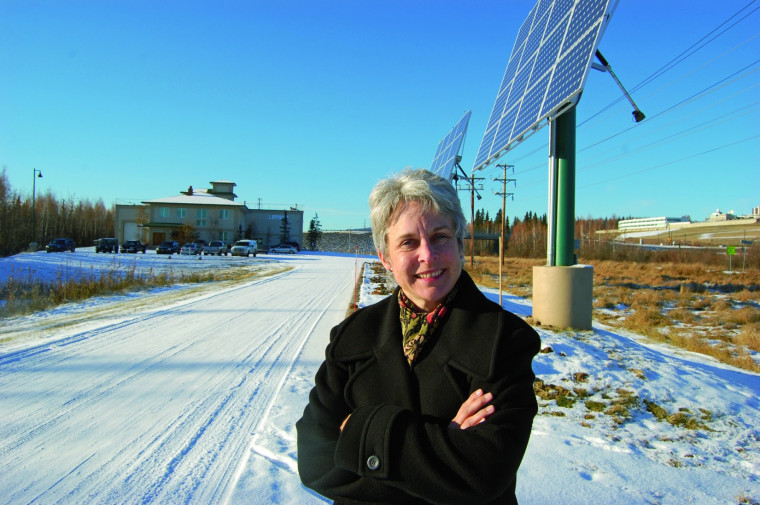Turning Up the Heat on Cold Climate Housing
Open gallery

In the dead of winter in Fairbanks, Alaska, when temperatures average 10 degrees below zero—and sometimes drop to 40 below—Suzanne Bishop BS ’82 is is snug and safe inside the Cold Climate Housing Research Center, monitoring high-tech sensors, compiling data, and planning for her summer garden.
“On December 21, we have 3 hours of daylight. The sun rises slightly above the horizon like a dim twilight,” she says. “On June 21, we have 3 hours of dusk and 21 hours of bright sunshine.”
The Cold Climate Housing Research Center is an industry-based nonprofit corporation; its facility is located on land owned by the University of Alaska at Fairbanks. “Our mission is to promote safe, affordable, durable, and energy-efficient housing for cold climate regions,” says Bishop, the center’s outreach director and one of 27 staff members. “Alaska is our home base, but we represent circumpolar regions across the globe. We have strong connections in Canada and have recently reached out to Scandinavia.”
Born in Nome, Alaska, Bishop headed south to Lewis & Clark, where she briefly studied music before switching her major to theatre. She says the collaborative spirit of the theatre department guided her professional vision toward teamwork and community. “Our professors jumped in wherever they were needed and expected us to do the same,” she remembers.
After graduation, Bishop spent many years working as a fund-raiser and public relations professional in Alaska and Washington, D.C. However, she was always plagued by a nagging discontent. With the help of a career coach, she discovered an unexpected desire to study library science. She earned her master’s degree in the subject from Syracuse University in 2003.
“My real strength lies in working one-on-one with people in a community setting,” she says. “Being a librarian helped me gain that perspective.”
At the Cold Climate Housing Research Center, Bishop draws on all her skills to promote, organize, research, and deliver detailed information requested by visitors, stakeholders, staff, and community members.
The Alaska State Home Builders Association founded the center in 1999 as a living laboratory. “Home builders had a collective knowledge of how to build energy-efficient homes here, but they wanted to conduct hard scientific research to back up their intuitive expertise,” says Bishop.
Drawing upon data from hundreds of sensors, staff at the center monitor the permafrost beneath the building’s foundation, indoor and outdoor air temperatures, indoor air quality, and effluent from chimneys. Some of this information is shared in real time on the organization’s website.
The center also works with communities to design prototype homes that solve cold-weather building problems while honoring local customs. For example, caribou hunting is an established custom in northern Alaska’s Anaktuvuk Pass. The prototype home there incorporates a large, exterior cold area for carving and storing carcasses. Other cold-weather designs include octagonal homes that deflect pummeling wind and rain.
While winter rages in Alaska, Bishop enjoys her indoor hobbies: reading, knitting, and preparing for gardening. She contributes her knowledge and some of her plants to the center’s eco-friendly garden roof, which in turn supplies local food banks.
“Gardeners in Alaska are always looking for ways to stretch the growing season,” she says. “I start seeds indoors in February and usually have small plants in the ground by Memorial Day weekend, expecting a mid- to late-August harvest. Last year, we had lettuce in the middle of April, about six weeks earlier than anyone else in Fairbanks.
—by Pattie Pace
More L&C Magazine Stories
Lewis & Clark Magazine is located in McAfee on the Undergraduate Campus.
MSC: 19
email magazine@lclark.edu
voice 503-768-7970
fax 503-768-7969
The L&C Magazine staff welcomes letters and emails from readers about topics covered in the magazine. Correspondence must include your name and location and may be edited.
Lewis & Clark Magazine
Lewis & Clark
615 S. Palatine Hill Road MSC 19
Portland OR 97219

